Best Classic Story Books of All Time for Kids: A Guide by Age and Theme
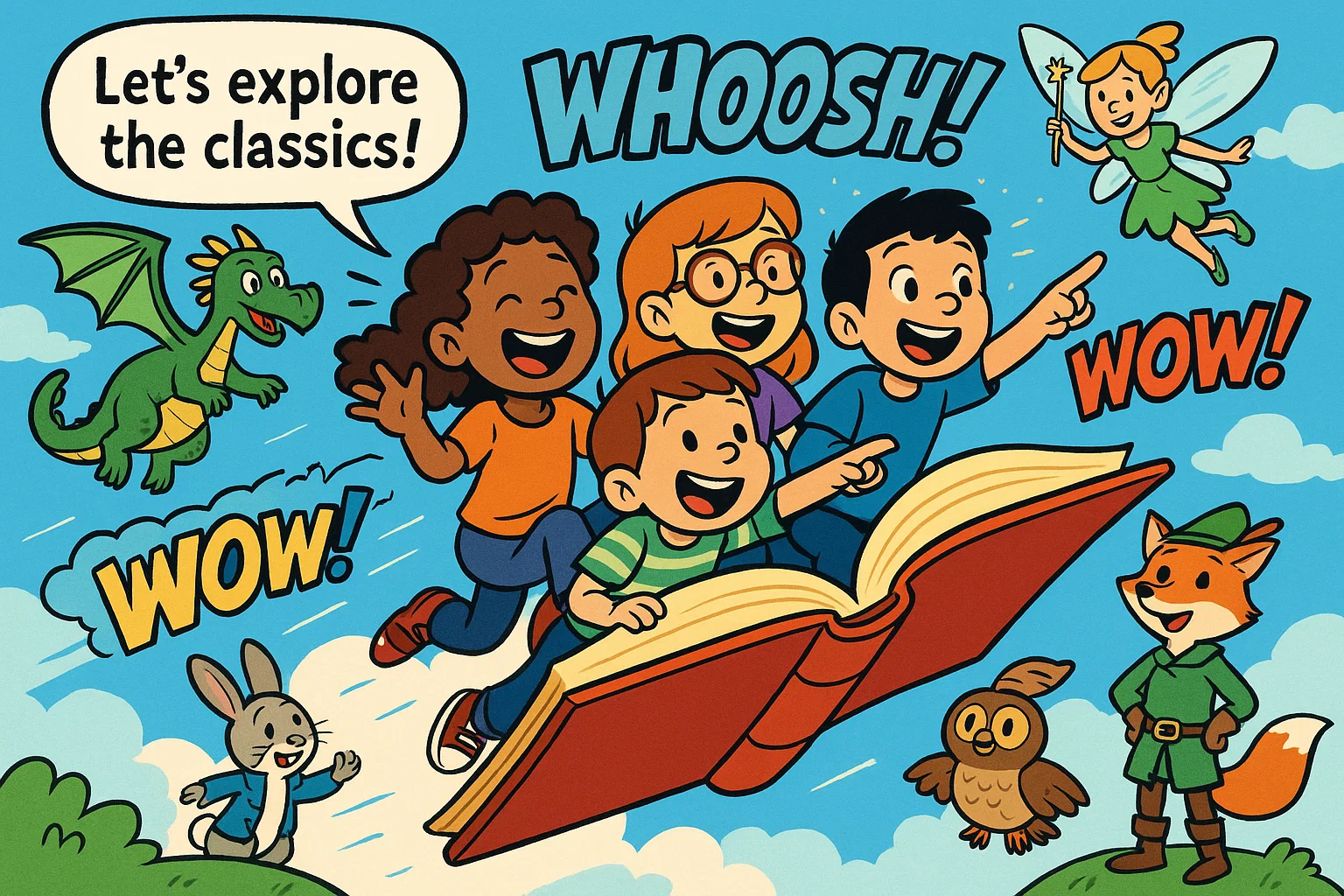
For parents, teachers, and librarians, navigating the vast and wonderful world of children’s literature can be a delightful but sometimes daunting task. With countless titles spanning generations, how do you find the perfect book for a child, whether they’re just starting to explore words or are already an independent reader? This guide is designed to help you curate a bookshelf filled with timeless classic stories that will enchant young readers and adults alike. This guide explores the hallmarks of great children’s literature, from rhythmic picture books to sprawling adventure sagas, and offers a hand-picked selection of classic children’s books organized by age, theme, and reading level. This curated list focuses on quality, lasting appeal, and the subtle life lessons these stories impart, ensuring you can choose titles that not only entertain but also help a child grow.
Our selections include beloved children’s books that have captivated generations of children, from those first published nearly a century ago to more modern classic titles with staying power. It also offers insights into what makes a book a classic tale and provide practical advice on how to use these stories to foster a love of reading.
Picture Classic Books
Picture books are a cornerstone of early childhood literacy. They are the first books we often share with our children, and their purpose is to introduce the joy of stories and the magic of words. Hallmarks of a great picture book include strong visuals, memorable characters, and a structure that is perfect for a read-aloud experience. The best of these use repetition and rhythm to captivate pre-readers and early readers, making them want to revisit the story again and again. Consider the simple, satisfying cadence of Eric Carle’s The Very Hungry Caterpillar or the whimsical illustrations in Maurice Sendak’s Where the Wild Things Are. These are the books that build a child’s foundation for reading.
Bedtime Classics
These books are chosen for their soothing cadence and reassuring plots, which make them perfect for winding down the day. The gentle rhythm and heartwarming endings can turn storytime into a cherished nightly ritual.
- Goodnight Moon by Margaret Wise Brown (Ages 1-4): This iconic book, with its quiet, repetitive rhyme, is a quintessential bedtime read-aloud. Its gentle pace helps children transition from a busy day to a calm evening.
- Guess How Much I Love You by Sam McBratney (Ages 2-5): A sweet, heartwarming exchange between Big Nutbrown Hare and Little Nutbrown Hare that perfectly captures the boundless nature of love.
- The Runaway Bunny by Margaret Wise Brown (Ages 2-5): A beautiful story of a mother’s unwavering love, assuring a child they will always be found and cherished.
- Llama Llama Red Pajama by Anna Dewdney (Ages 2-5): A modern classic with a relatable message about waiting for mom to come back, told with a catchy rhyme.
Animal Friends
Stories about animal characters often provide a gentle way to introduce empathy, friendship, and simple problem-solving. These crowd-pleasers are filled with gentle humor and opportunities for pattern recognition.
- Corduroy by Don Freeman (Ages 3-6): The story of a bear on a quest to find his missing button is a classic tale about finding a home and being accepted for who you are.
- The Gruffalo by Julia Donaldson (Ages 3-7): A clever mouse outsmarts a fearsome creature in this unforgettable story with a fun, repeating structure that kids love.
- Where the Wild Things Are by Maurice Sendak (Ages 4-8): Max’s journey to the land of the wild things explores the big feelings of anger and the comfort of returning home. The bold artwork and surreal journey invite pretend play and discussion.
- The Tale of Peter Rabbit by Beatrix Potter (Ages 3-7): This classic tale of a mischievous rabbit and his daring adventures in Mr. McGregor’s garden is a staple of children’s literature.
- Paddington by Michael Bond (Ages 4-8): The delightful bear from darkest Peru and his adventures in London are filled with gentle humor and a sense of wonder. The first Paddington book, A Bear Called Paddington, was first published in 1958.
Imagination Sparks ✨
These books are known for their bold artwork, surreal journeys, and their invitation to pretend to play. Reading them together encourages a child’s creative spirit.
- Harold and the Purple Crayon by Crockett Johnson (Ages 3-6): A simple yet brilliant story where a boy draws his own adventure, demonstrating the power of a child’s imagination.
- Journey by Aaron Becker (Ages 4-8): A wordless book that encourages readers to create their own narrative as a girl with a red marker draws a magical door to a new world.
- Swimmy by Leo Lionni (Ages 4-8): A small black fish leads his school to safety in a beautiful, artistic story about ingenuity and courage.
For Elementary Readers
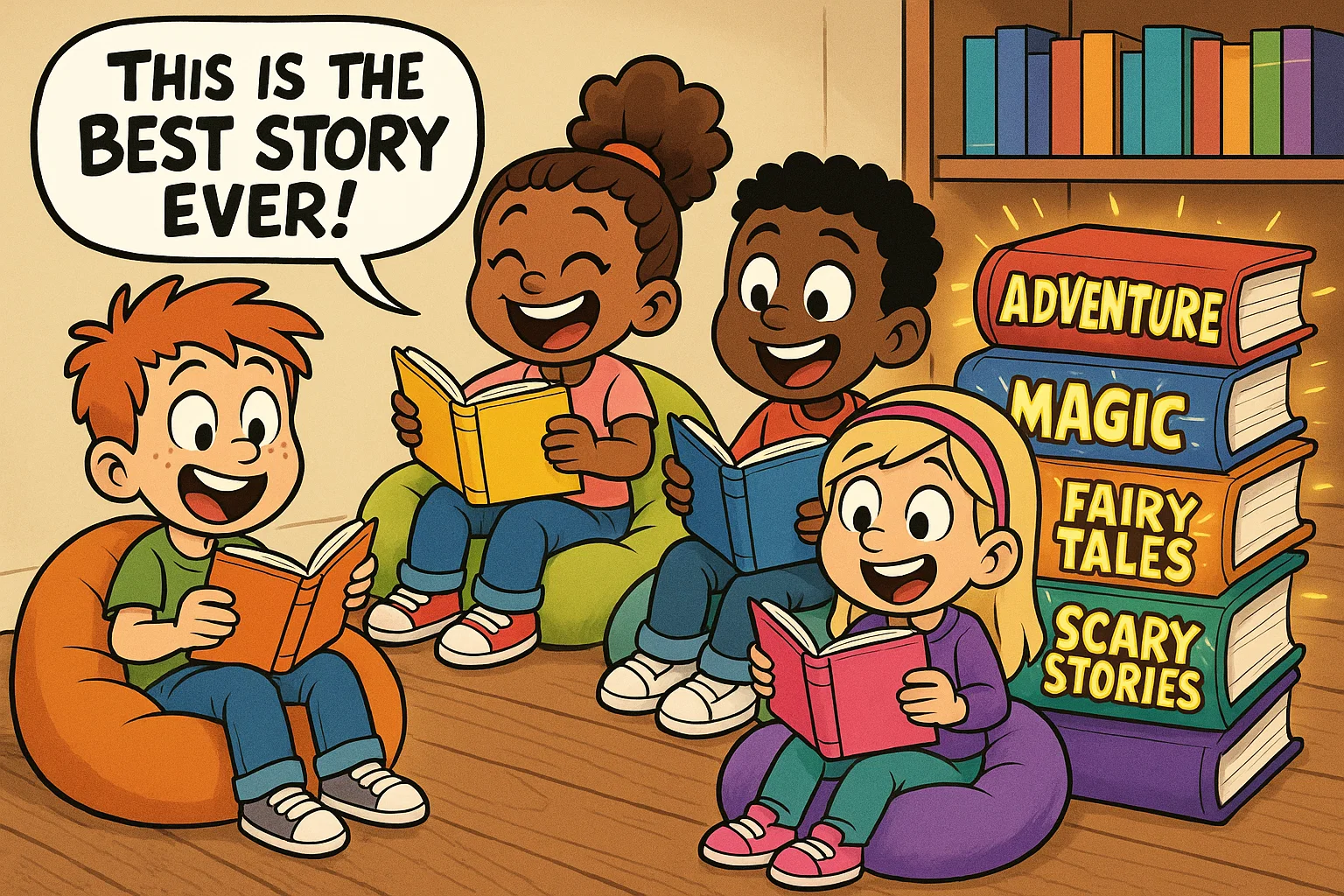
This stage marks a significant bridge between picture books and longer chapter books. The focus shifts to slightly more complex plots, longer sentences, and a greater reliance on sight words. These books help build a child’s reading stamina and comprehension.
Early Readers 📖
These books are characterized by short chapters, high repetition, and friendly fonts, making them the perfect entry point for newly independent readers.
- Frog and Toad Are Friends by Arnold Lobel (Ages 6-8): This series of heartwarming stories about two friends, Frog and Toad, teaches gentle life lessons about friendship and patience.
- The Magic Tree House Series by Mary Pope Osborne (Ages 6-9): Jack and Annie’s adventures through time are a perfect on-ramp to series reading, blending history and fantasy.
- Mercy Watson by Kate DiCamillo (Ages 6-8): A silly, fun-filled series about a pig who loves buttered toast, great for kids who enjoy humor.
Friendship Stories
Stories about friendship and social dynamics are key at this age, helping children navigate their own classroom and playground relationships.
- Charlotte’s Web by E.B. White (Ages 7-10): A timeless classic about the extraordinary friendship between a pig named Wilbur and a clever spider named Charlotte. It’s a beautifully told coming-of-age story that explores themes of life and death in a gentle, accessible way.
- A Boy Called Bat by Elana K. Arnold (Ages 6-9): An endearing story about a boy on the autism spectrum who takes care of a baby skunk, teaching empathy and celebrating differences.
- The Wind in the Willows by Kenneth Grahame (Ages 8-12): The adventures of Mole, Badger, Rat, and Toad along the riverbank are a quintessential classic book about friendship, loyalty, and the comforts of home.
For Middle-Grade Readers
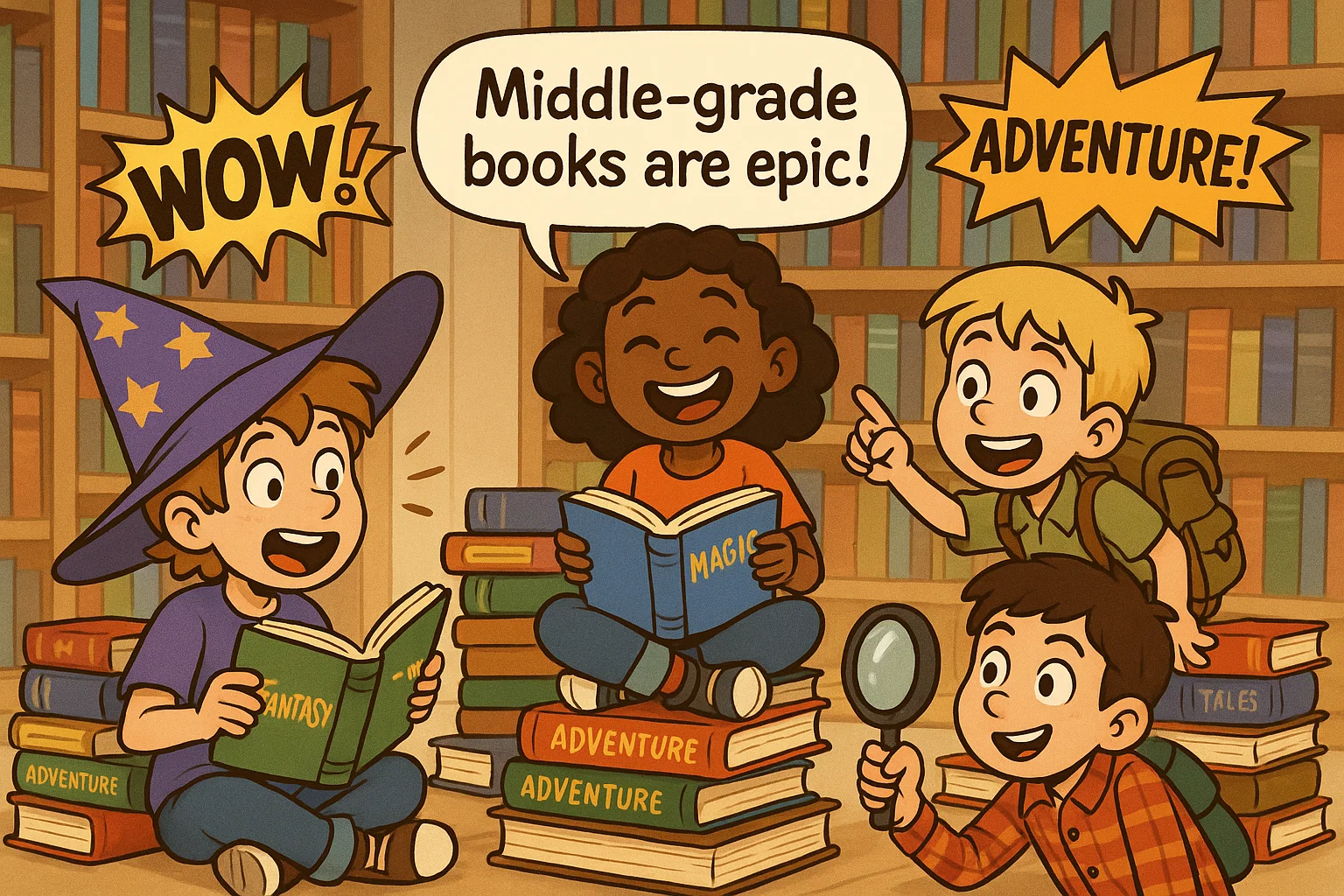
Middle-grade books introduce richer, more intricate plots, complex character arcs, and often, the appeal of a long series. At this stage, reading becomes a more immersive, independent activity.
Adventure Quests
These books are perfect for young readers who love journeys, puzzles, and a sense of peril. They build stamina for longer reads and often come with maps and clues to follow.
- Peter Pan by J.M. Barrie (Ages 9-12): The quintessential classic book about a boy who never grows up and his adventures with the Lost Boys in Neverland, facing off against the fearsome Captain Hook. It’s a whimsical and bittersweet tale that never gets old.
- The Lion, the Witch and the Wardrobe by C.S. Lewis (Ages 8-12): The first in The Chronicles of Narnia series, this story of four siblings who discover a magical world through a wardrobe is a pillar of fantasy literature.
- The Hobbit by J.R.R. Tolkien (Ages 10-14): An epic journey that introduces young readers to high fantasy, with a reluctant hero and a quest for treasure.
Fantasy Worlds
Fantasy allows for rich world-building and exploration of deep themes through a magical lens. These stories often have roots in mythology and folklore.
- Harry Potter and the Sorcerer’s Stone by J.K. Rowling (Ages 9-13): The start of a phenomenon, this book, first published in 1997, introduces an orphan who discovers he’s a wizard. It’s now a quintessential modern classic that has defined a generation.
- A Wrinkle in Time by Madeleine L’Engle (Ages 10-14): A science-fantasy classic about a young girl, Meg Murry, who travels through space and time to save her father. The novel explores complex themes of individuality, non-conformity, and good versus evil.
- The BFG by Roald Dahl (Ages 8-12): The story of a kind Big Friendly Giant who collects dreams and befriends a young girl named Sophie. This is a whimsical, delightful, and highly imaginative Roald Dahl book.
School Life
These stories, often filled with humor and heart, reflect the realistic stakes and social dynamics of school, making them highly relatable.
- Matilda by Roald Dahl (Ages 8-12): A brilliant young girl with a love for books and a telekinetic ability faces down her cruel parents and the terrifying headmistress, Miss Trunchbull. It’s a powerful story about standing up to bullies and the power of knowledge.
- The Worst Witch by Jill Murphy (Ages 7-10): This charming series follows Mildred Hubble, an accident-prone witch attending Miss Cackle’s Academy. It’s a fun, accessible take on boarding school life with a magical twist.
Age Guide
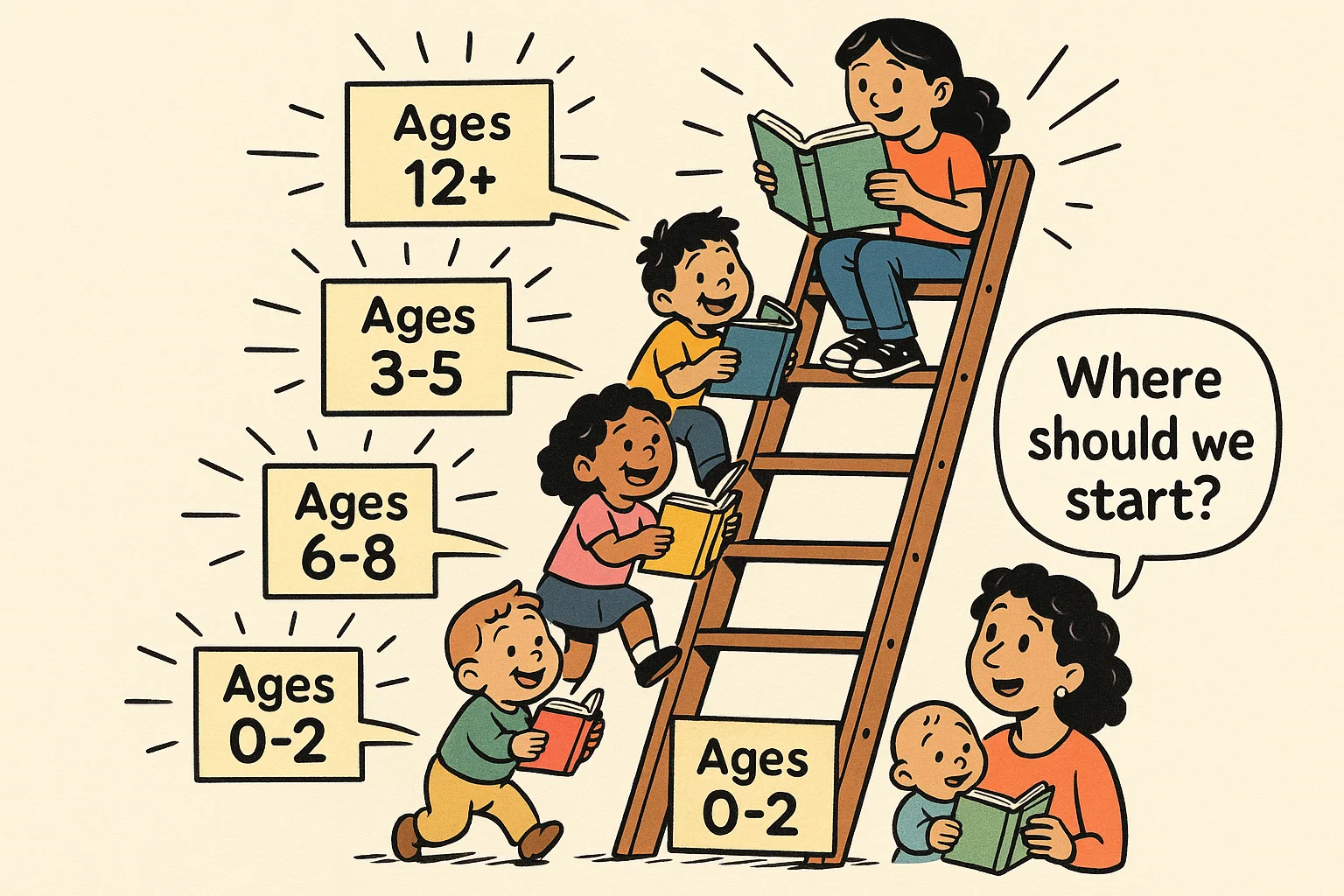
Choosing a book that aligns with a child’s developmental stage is crucial. These age ranges are flexible and often overlap, so always consider the individual child’s interests and reading habits.
- Ages 0-2: Focus on sensory experiences. Board books with high-contrast art and simple, repetitive text are essential. Goodnight Moon and The Very Hungry Caterpillar are perfect examples.
- Ages 3-5: This is the prime age for picture books. Look for those with rhyme, pattern, and gentle conflict, like Where the Wild Things Are or The Gruffalo. Read-aloud sessions at this age are magical.
- Ages 6-8: Early chapter books become important here. This is the age to introduce series like Frog and Toad or Mercy Watson to build reading stamina.
- Ages 9-12: Deeper narratives and themes are welcome. This is when independent reading truly takes off. Balance classic stories like The Hobbit with modern classic hits.
- Ages 12+: This is a great time to introduce more complex, often dystopian or coming-of-age themes. Classics like The Outsiders or contemporary novels with deeper philosophical questions are great. Be mindful of content sensitivity and guide the conversation.
Girl Heroes and Strong Leads
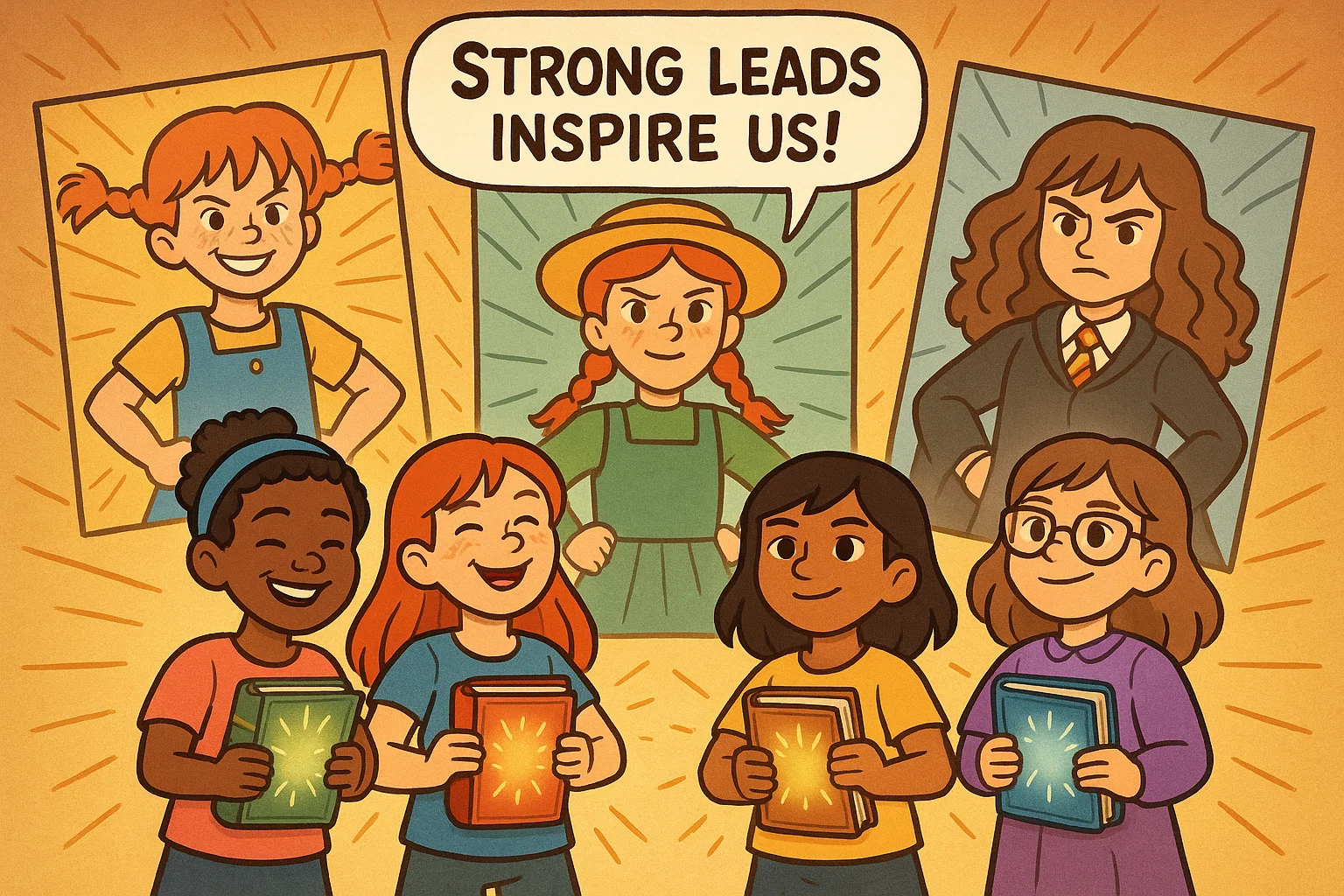
Highlighting books with female protagonists who demonstrate agency, courage, and curiosity can be a powerful way to inspire young readers.
- Trailblazers: Pippi Longstocking by Astrid Lindgren is an early classic book that set the template for fearless, independent girl heroes. Pippi is a free-spirited, super-strong girl who lives on her own and marches to the beat of her own drum.
- Curious Minds: Matilda by Roald Dahl is a classic example of a curious, book-loving girl who uses her mind to overcome obstacles. She is a testament to the power of intelligence and a love for reading.
- Quiet Strength: Ramona Quimby, Age 8 by Beverly Cleary shows a girl navigating the everyday challenges of school and family life with empathy and resilience. Her character arc demonstrates quiet, relatable strength.
Timeless Themes
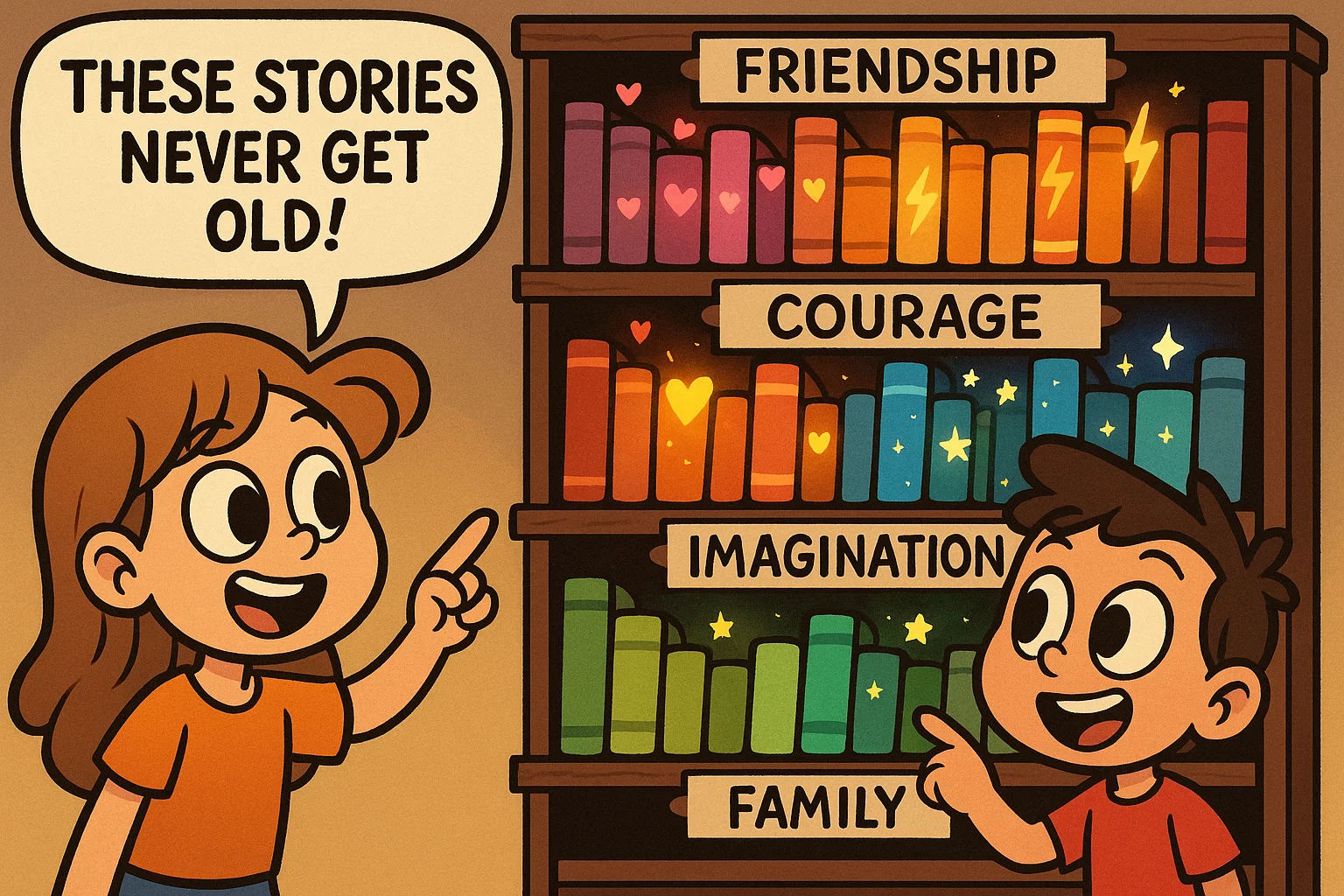
Organizing books by theme can help you find the perfect read for a child’s mood or a specific lesson you want to discuss.
| Theme | Classic Example | Lesson to Discuss |
| Friendship & Kindness | Charlotte’s Web | The value of loyalty and selflessness. |
| Courage & Growth | The Wizard of Oz | Finding courage within yourself. |
| Nature & Seasons | The Wind in the Willows | The beauty of the natural world and the comfort of home. |
| Make-believe & Play | Where the Wild Things Are | How imagination can help us process big emotions. |
Poetry and Rhyme
Introducing children to poetry early can enhance their phonological awareness and love of language.
Classic Rhyme
- A Child’s Garden of Verses by Robert Louis Stevenson: A delightful collection of poems about childhood experiences, perfect for a gentle introduction to classic verse.
- Where the Sidewalk Ends by Shel Silverstein: A fun, witty, and often whimsical collection of poems that kids love. The simple illustrations and memorable lines make it a favorite for children and adults alike.
Series and Reading Order 📚
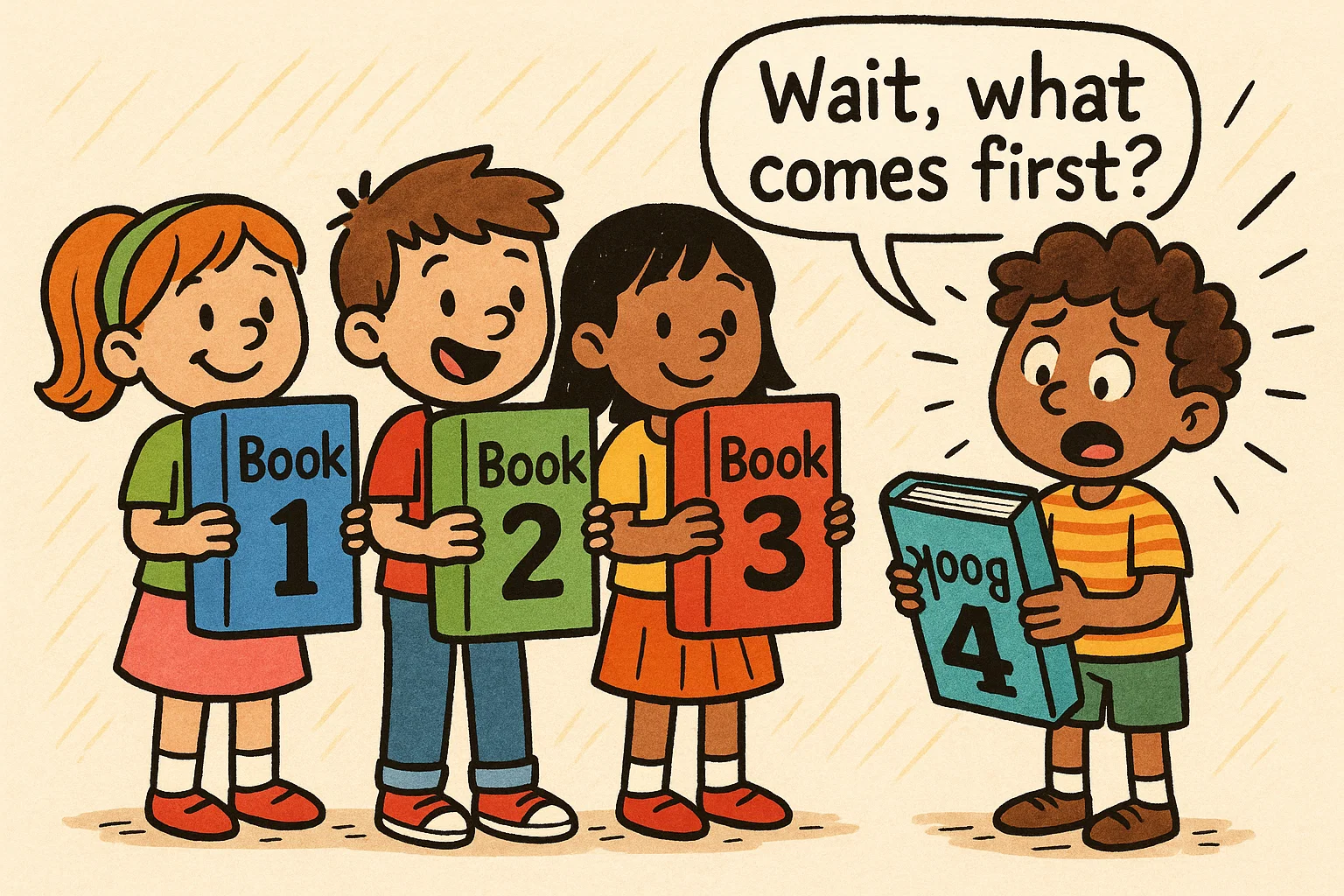
For many young readers, a good series is a gateway to a lifelong reading habit. Knowing the order can be a big help.
Starter Series
- The Princess in Black by Shannon Hale and Dean Hale (Ages 6-8): A highly engaging series about a princess who secretly fights monsters. Start with The Princess in Black and continue from there.
- Zoey and Sassafras by Asia Citro (Ages 6-9): Perfect for young STEM readers, this series blends science and fantasy as Zoey uses the scientific method to help magical creatures.
Epic Sagas
- The Chronicles of Narnia by C.S. Lewis (Ages 8-12): The seven books in this epic saga should ideally be read in publication order, starting with The Lion, the Witch and the Wardrobe.
- Harry Potter by J.K. Rowling (Ages 9-13): The seven-book series gets progressively more complex and mature, making it a great way to map complexity to a reader’s growing stamina.
How to Choose
When standing in a bookstore or library, how do you make the right choice? Here’s a simple framework to help you decide.
- Reading Level Fit: While Lexile ranges and other tools can be helpful, the “five-finger rule” is a great, simple tool. Open the book to a random page and have the child read it. If they struggle with more than five words on the page, the book might be too challenging.
- Interest Match: What are the child’s hobbies? Do they love animals, space, or magic? Matching a book to a child’s interests is the single best way to ensure they’ll enjoy it.
- Re-read Potential: A truly great children’s book has re-read potential. The kind of book kids will return to year after year, finding something new each time.
Read-Aloud Tips
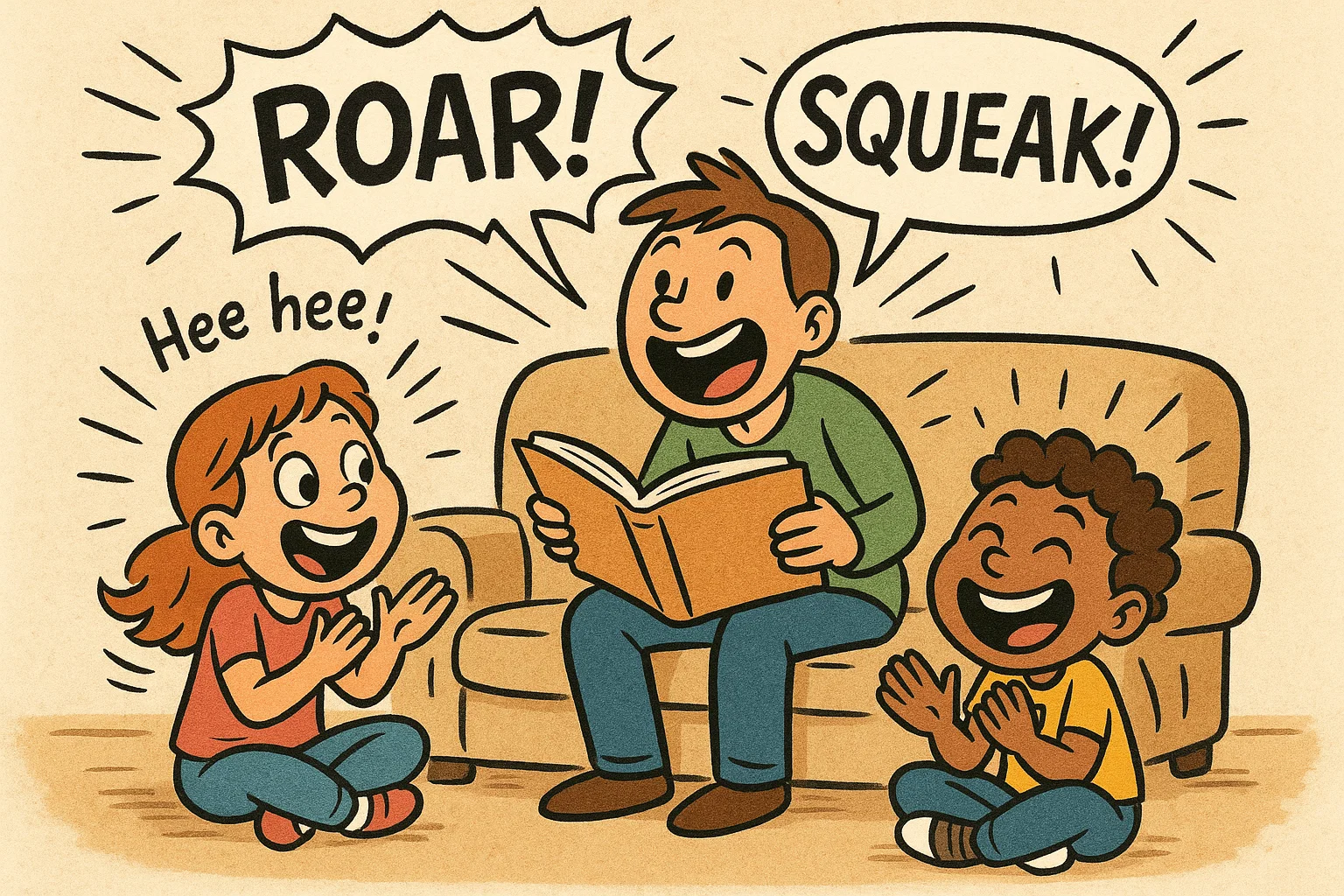
Reading aloud is an art, and it’s a powerful way to foster a child’s love of books.
- Voice and Pacing: Use different voices for characters to bring the story to life. Vary your pacing, pausing for suspense or to let the child look at the pictures.
- Comprehension Boosts: Before you start, look at the cover and ask, “What do you think this book is about?” During the story, ask questions like, “What do you think will happen next?”
- Routine Builders: Make reading a part of your daily routine. Bedtime is a classic, but a “read-aloud” can happen in the morning or on a cozy weekend afternoon.
Childhood Favorites Classic Books List ✨
This section provides a quick-reference list of some of the best classic and modern classic children’s books across different age groups.
Essential Starters
- Goodnight Moon by Margaret Wise Brown: The perfect calming read-aloud for toddlers.
- Where the Wild Things Are by Maurice Sendak: A cornerstone of imaginative play.
- The Very Hungry Caterpillar by Eric Carle: A simple and beautiful story that teaches about days of the week, numbers, and the life cycle of a butterfly.
- Oh, the Places You’ll Go! by Dr. Seuss: A classic for all ages, with a powerful message about facing life’s challenges.
- The Gruffalo by Julia Donaldson: A clever, rhythmic story that kids love.
- The Tale of Peter Rabbit by Beatrix Potter: A charming story about a mischievous rabbit that has endured for over a century.
- Winnie-the-Pooh by A.A. Milne: A gentle, heartwarming story about friendship and adventure in the Hundred Acre Wood. The character of Winnie-the-Pooh has delighted generations.
- The Snowy Day by Ezra Jack Keats: A landmark book that was one of the first to feature a person of color as the protagonist of a mainstream children’s story, it captures the simple joys of a winter day.
- Corduroy by Don Freeman: A reassuring story about finding a friend and being loved for who you are.
- The Little Prince by Antoine de Saint-Exupéry: A beautiful allegory that speaks to both children and adults alike, exploring themes of love, loss, and friendship.
More Timeless Classics to Complete Your Collection
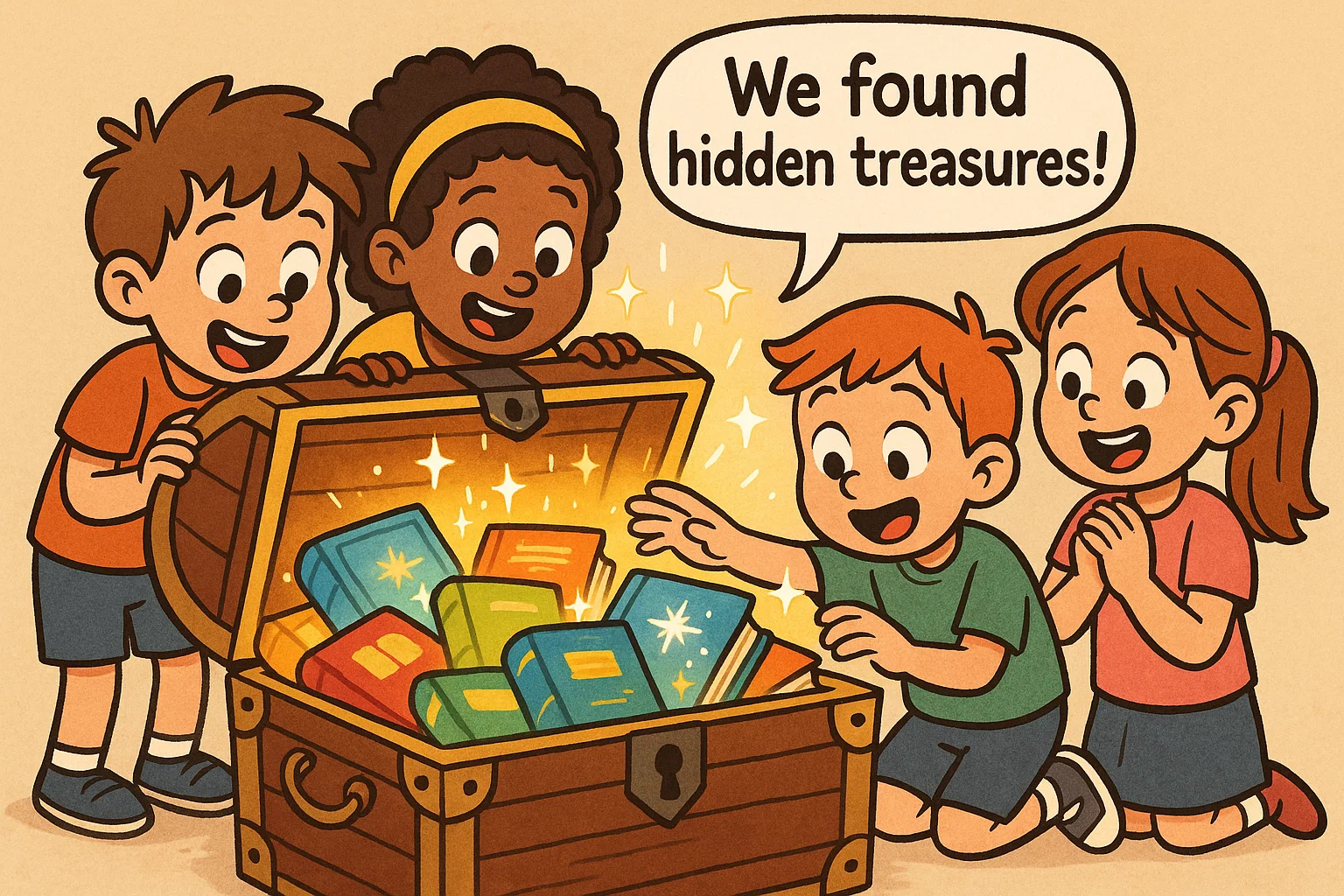
To expand on the fantastic books already highlighted in this guide, here is an additional list of 62 classic children’s books and modern staples. Organized by theme, this comprehensive table makes it easy to find new favorites and build an even more robust library for the young readers in your life.
| Fantasy & Adventure | Classics & Timeless Tales | Early Readers & Humor | Poetry & Imagination | Everyday Life & Friendship |
| The Chronicles of Narnia by C.S. Lewis | Heidi by Johanna Spyri | Junie B. Jones by Barbara Park | A Light in the Attic by Shel Silverstein | The Boxcar Children by Gertrude Chandler Warner |
| The Hobbit by J.R.R. Tolkien | Anne of Green Gables by L.M. Montgomery | Captain Underpants by Dav Pilkey | The New Kid on the Block by Jack Prelutsky | Tales of a Fourth Grade Nothing by Judy Blume |
| The Wizard of Oz by L. Frank Baum | The Velveteen Rabbit by Margery Williams Bianco | Diary of a Wimpy Kid by Jeff Kinney | The Random House Book of Poetry for Children by Jack Prelutsky | From the Mixed-Up Files of Mrs. Basil E. Frankweiler by E.L. Konigsburg |
| Alice’s Adventures in Wonderland by Lewis Carroll | The Giver by Lois Lowry | Knuffle Bunny by Mo Willems | D’Aulaires’ Book of Greek Myths by Ingri and Edgar Parin d’Aulaire | The Secret Garden by Frances Hodgson Burnett |
| Mary Poppins by P.L. Travers | The Outsiders by S.E. Hinton | Don’t Let the Pigeon Drive the Bus! by Mo Willems | American Tall Tales by Adrianne Adams | Maniac Magee by Jerry Spinelli |
| My Father’s Dragon by Ruth Stiles Gannett | Holes by Louis Sachar | The One and Only Ivan by Katherine Applegate | Fairy Tales by Hans Christian Andersen | Old Yeller by Fred Gipson |
| Mrs. Frisby and the Rats of NIMH by Robert C. O’Brien | Where the Red Fern Grows by Wilson Rawls | Sideways Stories from Wayside School by Louis Sachar | Grimm’s Fairy Tales by Brothers Grimm | Because of Winn-Dixie by Kate DiCamillo |
| The Dark Is Rising by Susan Cooper | Shiloh by Phyllis Reynolds Naylor | Goosebumps by R.L. Stine | Brown Bear, Brown Bear by Bill Martin Jr. | The Wind in the Willows by Kenneth Grahame |
| Ella Enchanted by Gail Carson Levine | A Series of Unfortunate Events by Lemony Snicket | Lyle, Lyle, Crocodile by Bernard Waber | Chicka Chicka Boom Boom by Bill Martin Jr. and John Archambault | Charlotte’s Web by E.B. White |
| Eragon by Christopher Paolini | Tuck Everlasting by Natalie Babbitt | The Cat in the Hat by Dr. Seuss | The Giving Tree by Shel Silverstein | Paddington by Michael Bond |
| Percy Jackson & the Olympians by Rick Riordan | Henry and Mudge by Cynthia Rylant | Green Eggs and Ham by Dr. Seuss | Press Here by Hervé Tullet | The Mysterious Benedict Society by Trenton Lee Stewart |
| Artemis Fowl by Eoin Colfer | Bridge to Terabithia by Katherine Paterson | Llama Llama Red Pajama by Anna Dewdney | Stone Soup by Marcia Brown | The Phantom Tollbooth by Norton Juster |
| Scary Stories to Tell in the Dark by Alvin Schwartz | Stuart Little by E.B. White | Blueberries for Sal by Robert McCloskey | Roll of Thunder, Hear My Cry by Mildred D. Taylor | |
| Lyle, Lyle, Crocodile by Bernard Waber | The Little House by Virginia Lee Burton | Harold and the Purple Crayon by Crockett Johnson | The Indian in the Cupboard by Lynne Reid Banks | |
| If You Give a Moose a Muffin by Laura Numeroff | Mike Mulligan and His Steam Shovel by Virginia Lee Burton | Journey by Aaron Becker | Bud, Not Buddy by Christopher Paul Curtis | |
| Hop on Pop by Dr. Seuss | Swimmy by Leo Lionni | The Giver by Lois Lowry | ||
| Oh, the Thinks You Can Think! by Dr. Seuss | Fox in Socks by Dr. Seuss | The Runaway Bunny by Margaret Wise Brown | ||
| One Fish Two Fish Red Fish Blue Fish by Dr. Seuss | The Little Prince by Antoine de Saint-Exupéry | Guess How Much I Love You by Sam McBratney | ||
| Lyle, Lyle, Crocodile by Bernard Waber | ||||
| If You Give a Mouse a Cookie by Laura Numeroff |
Related Reads 📚
- Best Books for 6-8-Year-Olds: For a deeper dive into early chapter books and transitional reads, explore our curated list of leveled picks.
- Classic Books for 9-12-Year-Olds: Find a comprehensive guide to middle-grade literature, including series maps and thematic recommendations.
- Girl Hero Books: Discover our list of empowering reads featuring strong, brave, and curious female characters.
- Bedtime Picture Books: A short, soothing set of books perfect for young children and nightly rotation.
FAQs 🤔
What counts as a classic childhood book?
A classic children’s book is typically defined by its enduring popularity, cultural impact, and continued relevance across generations. These are the books that remain in print, are frequently reprinted, and are cherished by both children and adults alike. A good rule of thumb is a book that has been loved for at least 25-50 years and continues to sell well.
How many classics should a child's starter bookshelf have?
A great starter bookshelf can have as few as 10-15 carefully chosen classics across different age groups. It’s not about quantity but about creating a core collection of truly great, timeless classic stories that a child will want to revisit. For a new baby, a few board books and a lift-the-flap book are a great start.
When should a child try an unabridged edition?
Unabridged editions are often ready when a child has the reading stamina to tackle a longer, denser text. If a child enjoys an abridged version of a classic tale and shows a strong interest in the characters and plot, it’s a good sign they are ready to try the full version. A side-by-side test can help you decide. For example, if your child is reading shorter chapter books independently, they may be ready for the unabridged Peter Pan.
How do I balance classics with new releases?
A good reading plan involves a rotation. A great ratio might be to have two new releases for every one classic book. This ensures your child is exposed to the rich history of children’s literature while also reading stories that reflect the world they live in today. Reading classic fairy tales alongside modern twists on them, or a book by Roald Dahl next to a contemporary middle-grade humor title, can be a fun way to compare and contrast.
What makes The Very Hungry Caterpillar so special?
This classic book is so much more than a simple story. It’s a brilliant combination of vibrant visual design, a simple but engaging plot, and educational elements. Children learn to count, identify the days of the week, and watch the magical transformation of a caterpillar into a butterfly. The unique format with “eaten” holes in the pages makes it an interactive and tactile experience, which is especially important for very young readers. It’s the ultimate lift-the-flap book that both teaches and entertains.
Why does Goodnight Moon help children sleep?
Margaret Wise Brown’s Goodnight Moon is not just a tale, it’s a ritual. Its calming, rhythmic text and the gradual darkening of the illustrations create an atmosphere of tranquility. The repetition of words and phrases helps children relax and prepare for sleep, while the simple act of saying goodnight to familiar objects in the room helps them emotionally transition to bedtime. It is the quintessential bedtime classic that provides comfort and routine.
Why is Where the Wild Things Are* still so relevant?
Maurice Sendak’s story is a timeless exploration of big emotions. It allows children to safely explore feelings of anger, mischief, and loneliness, and then shows the ultimate comfort of returning home to where they are loved. The illustrations, which start small and expand to fill the entire page, mirror the emotional intensity, and then shrink again, symbolizing a return to calm. This classic book is a powerful reminder that even the biggest feelings can be navigated, and love will always be there.
Why are Margaret Wise Brown's books so enduringly popular?
Margaret Wise Brown’s books have a unique ability to connect with a child’s inner world. Her works, like Goodnight Moon and The Runaway Bunny, are built on simple, repetitive ideas that are calming and provide a sense of security. She was a master of using rhythm and melody in language to create texts that feel like lullabies. Her stories tap into the very core of a child’s experience, making her books essential for families looking to create nostalgic and gentle moments before bedtime.
Why do classic books evoke nostalgic feelings in adults?
Classic children’s books serve as a powerful bridge between generations. When parents read aloud to their children the books they loved themselves, they are not just sharing a story; they are sharing a part of their own personal history. This act of re-reading is like taking a trip back to their own childhood, a world of familiar characters and beloved plots. These books, from Winnie-the-Pooh to The Tale of Peter Rabbit, are full of emotions and memories, which makes the experience so deeply nostalgic and deeply connecting for children and adults alike.
